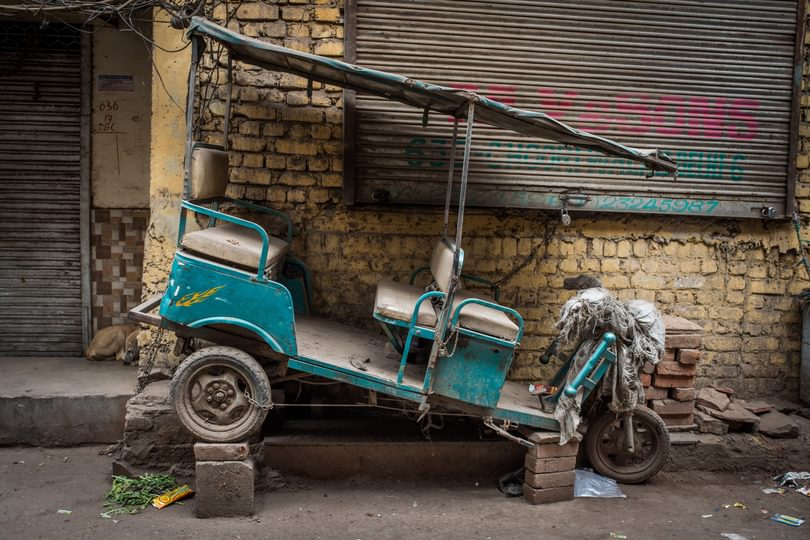
To understand the impacts of the pandemic on different groups it is important to engage with the experience at the margins of society and to examine the socially and long-lasting effects of the virus.
Squatter settlements are a key community in cities where the virus, and the state’s response to it, produce complex challenges.
The case of Sohanlal, an e-rickshaw driver, is an example of how mobilities and labour relations are interlinked. It shows the complexities of how the pandemic has impacted “mobile livelihoods” in the city. The transport infrastructure and the labour that form and maintain it are critical for the functioning of the metropolis. Informal settlements in Delhi play a key role in providing the transport workers in the city. Many residents of Sohanlal’s settlement are e-rickshaw drivers. Sohanlal, like his many co-residents, invested their limited means and modest aspirations in the informal transport sector. They are socially, spatially, and economically embedded in the city’s diverse and interconnected mobilities. How the pandemic impacts the lives of these workers is where we learn the long-term material and symbolic effects of coronavirus.
Sohanlal’s story
“Only if coronavirus had started two months later,” Sohanlal noted in a conversation in early October. “I paid all my kishts [instalments] on time. Only two kishts were left to be paid and I could not do it.” The lockdown in the city disrupted his difficult but, till that point, timely payment of the monthly instalments of the loan for his e-rickshaw. For him, the impact of the virus was primarily experienced through his e-rickshaw.
In early 2019, Sohanlal bought an e-rickshaw through a private finance company in the city. The cost of an e-rickshaw can exceed 100,000 INR (£1000).
“I had some money to make the initial payment and the rest I got from the company.” 90,000 INR was the amount financed by the company. “So, it became that I had to pay a 7,500 INR (£80) instalment each month for 15 months.”
“Work harder,” he made a commitment to himself. His primary goal for the immediate months became: to pay the instalment on time, each month. “I wanted to make my e-rickshaw loan-free” he emphasized.
Locked down
The initial announcement of the national lockdown in the country led to a massive movement of people from big cities to their home districts in different part of India. The squatter settlements in Delhi saw a treacherous exodus of the migrant residents back to their home states.
The e-rickshaw was their treasure, but its safekeeping also became an encumbrance
In Sohanlal’s settlement, half of the people left for their homes in Bihar and Uttar Pradesh. Sohanlal and his wife Kajal, however, decided to stay in the city. “We could not have left our e-rickshaw here and gone. And neither could we have taken it with us to our village,” Sohanlal explained as he noted the dilemma which the security of the e-rickshaw posed.
The e-rickshaw was their treasure, but its safekeeping also became an encumbrance restricting their ability to return to their place near Lucknow. Sohanlal resolved the issue by saying: “If we have to die, it does not matter if we die in our village or we die here in the city.”
Chained up
He stopped taking his e-rickshaw out for work completely. But inside the settlement, the e-rickshaw posed another challenge: parking. Prior to the pandemic, he would drive the e-rickshaw during the day and then during the night he would park it in a garage for overnight battery charging. This charging garage is run by another resident of the settlement.
The daily rate for the garage is 50 INR (£0.5). But due to the lockdown, Sohanlal could not afford this daily charge. Therefore, he had to store his e-rickshaw at an unsafe open site near his shanty. He locked his rickshaw there with additional chains. Also, fearing theft, he disconnected and removed the battery out of the e-rickshaw and stored it safely inside his shanty.
Powered down
The loss of the battery of his e-rickshaw shattered Sohanlal’s remaining hope
After the unlocking of the city, when he finally felt confident to resume working and decided to take his e-rickshaw out again in the city, he was dealt a big blow: the battery was damaged beyond recovery. “The battery died!”
The loss of the battery of his e-rickshaw shattered Sohanlal’s remaining hope. To buy a new battery would cost another 30,000 INR (£300) and he did not have any source for such funds (“From where I will get this kind of money?”). Therefore, the e-rickshaw remained parked near his shanty and the dead battery remained stored in his shanty.
Sohanlal used to work as a waste-picker in the city. The dream of an e-rickshaw was for him an aspiration of some material improvement and dignity. Now Sohanlal has returned to where he had started: recovering recyclables from the city’s waste. But he now also has additional debts from the loan that are slowly increasing. In informal settlements, I have heard people explaining untimely deaths many times by saying, “It is the debt which kills the person.” The financialization of poverty has shown us how debt and death conjugate.
Held back
The transport sector workers in the city were badly affected by the lockdown. In May, the Delhi government had announced a 5,000 INR (£50) onetime financial assistance to each e-rickshaw driver in the city. I inquired if he had applied for the assistance. “I do not have the documents,” Sohanlal replied.
The economic mobility that Sohanlal had briefly experienced got enmeshed in a different lockdown
The key documentary obstacle which Sohanlal reported was his lack of a permanent driving licence. He started driving the e-rickshaw on a learner’s licence. He is an expert and safe driver but lacks a formal licence.
To my inquiry about his issue of not applying for a permanent licence after the learner’s license, he replied with a hint of anger, “There are so many fees and people whom I need to pay for these things. Should I run my home or pay all these fees?” For Sohanlal what was important was that he paid his monthly loan instalments on time. Conversations with him suggested that he had planned to apply for a permanent licence after paying off the loans for his e-rickshaw.
The economic mobility that Sohanlal had hoped for and briefly experienced through his e-rickshaw got enmeshed in a different lockdown. The city started to unlock but his e-rickshaw was chained up, the battery was dead, and the debt was becoming heavy. A lockdown whose temporality and scope went beyond the formal state-ordained national lockdowns. A long lockdown.
Moving forwards
Sohanlal’s case is just one workers story, but many transport sector workers would recognise his fight to service debt and many e-rickshaw workers faced similar parking challenges through the lockdown and the changes it brought to the city. A large proportion of workers like Sohanlal were excluded from India’s government support. Even where they received it, support was limited, one-time-only and not even minimally sustainable for the duration of the lockdown.
Rebuilding local informal economies is going to be a complex and difficult process for many communities, not just Sohanlal’s. Although his is a specific story of only one family in one informal settlement, it paints a picture of the various and complex issues facing economies, industries, and their workers at various scales due to the pandemic. Whatever the solutions put in place the impacts will have a long tail and additional attention should be paid to those outside of the formal economic framework.
This opinion piece reflects the views of the author, and does not necessarily reflect the position of the Oxford Martin School or the University of Oxford. Any errors or omissions are those of the author.
